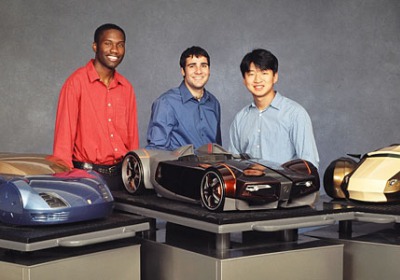CCS- American Iron and Steel Institute Challenge 2005
Tue, 15 Nov 2005 Transportation Design students from the College for Creative Studies in Detroit recently presented projects done in conjunction with the American Iron and Steel Institute (AISI). Three students were selected from the college to complete an internship: Chris Piscitelli, Sylvian Bryan and Sang Hoon Shin. They took on the challenge to design a 'functional, innovative and extreme-inspired vehicle that integrates environmental responsibility, cost efficiency and advanced steel materials.' Aside from the peripheral criteria, it is the 'extreme' theme that sticks, the brief satisfyingly encouraging students to really provoke with their imaginations.With the Challenge now in its 17th year, AISI puts its considerable resources to good use, Piscitelli, Bryan and Shin each receiving much support during their internship program, which includes producing scale models of their designs.
With inspiration neatly identified to fit brand and material use, 23 year-old Chris Piscitelli's design for his Acura Ronin was informed by the armour of samurai. 'This focused on detail, and extreme protection, yet did not weigh down the samurai or affect his ability to move and perform with accuracy, speed and agility.' Special use of steel in the chassis is proposed in order to minimise weight and costs. Though ronin are samurai without masters, the car is driver-orientated, with wrap-around glass and prominent roll-bars defining the driver's cocoon in an aesthetic that 'looks to F1 cars for formal inspiration.'
Sylvian Bryan formerly studied in Florida, gaining experience alongside Brazilian furniture designers Fernando and Humberto Campana. Having kept such illustrious company, AISI awarded the internship to Bryan for his 'trailblazing potential'. With 2050's presumably straight and flat roads as the context, Bryan uses today's Carrera GT as the basis for his Porsche XTT. Embracing concern for pedestrian safety in its smooth forms, Bryan also suggests 'this enhanced car of the future is an aerodynamic marvel.' Inside, the hydrogen tanks are placed atop one another as part of a safety cage, communicating the concerns future drivers will have about the environment. Needless to say, 'steel meets the requirements for Generation X's car enthusiast'.
Completing the trio is Sang Hoon Shin, originally from South Korea. His expressive model is also inspired by plate armour, this time from medieval Europe. 'This embraces the art of steel forging - specialized steel pieces, many with elaborate designs, to individualize and customize the armour.'
Says Shin 'I decided to use the aesthetics of armour, layering advanced high-strength steel blanks, to create a more aggressive styling design with an edgy appeal. I designed a car that follows the theme of plate armour, with the idea 'to protect its user.' The central peak, narrow window openings, and overlapped pieces project an aggressive form, yet the undulated surfaces flow across the entire vehicle.'
Shin's work displays the artistry Koreans have become reknowned for, while all three learnt the value of knowing about material properties and tooling processes as a means to support more experimental designs. Within the design industry, BMW Design Director Chris Bangle has clearly shown the benefits of such knowledge, it being this that allowed him to push the limits of steel pressing capabilities as part of the 'flame-surfacing' theme used to distinguish a generation of BMWs. Besides this, and despite political crossfire between industry and state on the issue of changing climes, it is reassuring to see these and environmental and social concerns on the minds of tomorrow's car designers.
By

